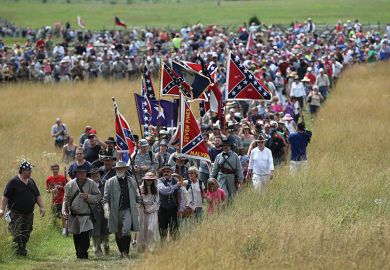Karal Ann Marling's book is an invitation to celebrate the dawning of the world as television. She takes us on a journey through 1950s American consumer culture, freshly liberated from the hardships of wartime. Christian Dior's first postwar collection attempted to "turn women into flowers", and the "New Look" in fashion prefigured important elements of the postwar aesthetic in America, an artfulness and attention to detail in matters of colour, line and form. This was directed not simply to clothes but across the whole range of material life; from food to car design. Marling lovingly guides us through this landscape, the world of what design critic Thomas Hine called the "populuxe", glitz and glitter for the postwar masses.
Her starting point is the fashion industry and a close analysis of the sartorial style of Mamie Eisenhower, a first lady dedicated to fashion, her wardrobe the centre of intense media and public interest.
It was Mamie's preference for pink which Marling suggests may have helped confirm the feminisation of that colour. The blue and pink gender coding we take for granted only began to harden into dogma after the Second World War.
Indeed, this heightened interest in colour is part of the aesthetic in general, whether applied to cars which take on an increasing range and combination of hues as the decade advances or to the colouring of areas previously resistant, for example, men's clothing. This trend was particularly clear in the case of food and food packaging, as is shown in Marling's discussion of the highly successful Betty Crocker's Picture Cook Book.
Betty Crocker, the idealised product of the collective imagination of the flour company General Mills' Home Service Department, produced recipes which were a series of pictures, with a minimum of fussy verbiage. This was cooking for a post-literate generation of "motherless exurbanites", but even Betty could be outdone, notably by Swanson's of Nebraska, the firm which produced the first TV dinner in 1953.
The 1950s Marling describes was an epoch when for the first time Thorstein Veblen's leisure class included almost everybody (on the face of it). But it is not necessarily a simple story. The period, in fact, showed a trend away from passive crowd amusements. The hobby had arrived; specialists in recreation referred to it as the fifth freedom. The home handyman was a neo-pioneer on the domestic frontier.
Alongside these developments Marling charts the popularity of painting-by-numbers kits and the whole movement of amateur art which the decade witnessed.
Meanwhile, a new American topos was being willed into being through the unholy alliance of a film studio with television. In the 1950s keen hobbyist, Walt Disney, was getting bored with the movies and dreaming of another project, Disneyland. While some critics carped, the public didn't mind the plastic crocodiles and by New Year's Eve 1957, under a year and a half after its opening in July 1955, attendance had reached ten million. Disneyland promoted weekend togetherness and the new American family. But it was through television in the early 1950s that Walt promoted Disneyland and thus assured its completion.
The other crucial ingredient that ensured the success of Disneyland was the automobile. Marling gives us a lengthy account of the evolution in form which occurred when Detroit replaced designers with stylists. The cars which were coming off the assembly lines were increasingly loaded with flashy chrome protuberances and tailfins until the public wanted no more and we come up against the debacle of the disastrous 1958 Ford Edsel.
Not only did television call for a reorganisation of the domestic space of the living room and the invention of new kinds of furniture such as the tray-tables that Ike and Mamie ate their supper from in front of specially installed consoles in the White House. Along with the newly designed furniture a whole new TV aesthetic emerged in the 1950s. Prior to this the medium had been little more than radio with black and white photographs, the performers rooted to their marks. But in the 1950s this all changed as cameras and performers began to move around. Elvis was one of the first to exploit this movement and part of his success hinged upon the fact.
By the end of the decade the distinctive aesthetic which emerged as suburbia came of age was beginning to change and suburbia itself and the values that it represented were coming into question as "suburban jitters" gave way to "Ulcerville". The whole period has found a sympathetic chronicler in Marling and her account of the influence of television on 1950s America makes for fascinating reading.
Gareth Stanton is a lecturer in media and communications, Goldsmiths College, University of London.
As Seen On TV: The Visual Culture of Everyday Life in the 1950s
Author - Karal Ann Marling
ISBN - 0 674 04882 2
Publisher - Harvard University Press
Price - £19.95
Pages - 328pp
Register to continue
Why register?
- Registration is free and only takes a moment
- Once registered, you can read 3 articles a month
- Sign up for our newsletter
Subscribe
Or subscribe for unlimited access to:
- Unlimited access to news, views, insights & reviews
- Digital editions
- Digital access to THE’s university and college rankings analysis
Already registered or a current subscriber? Login



